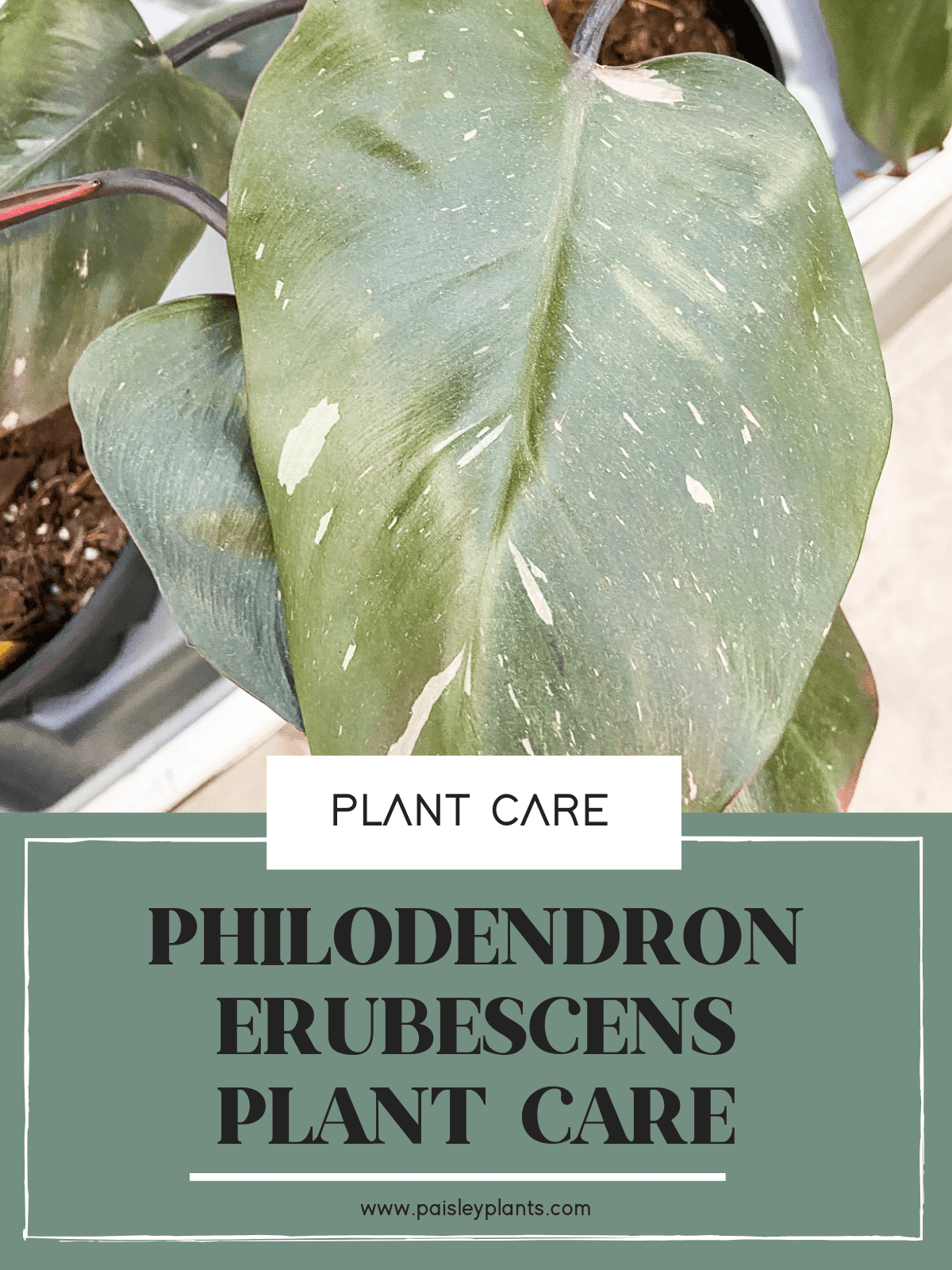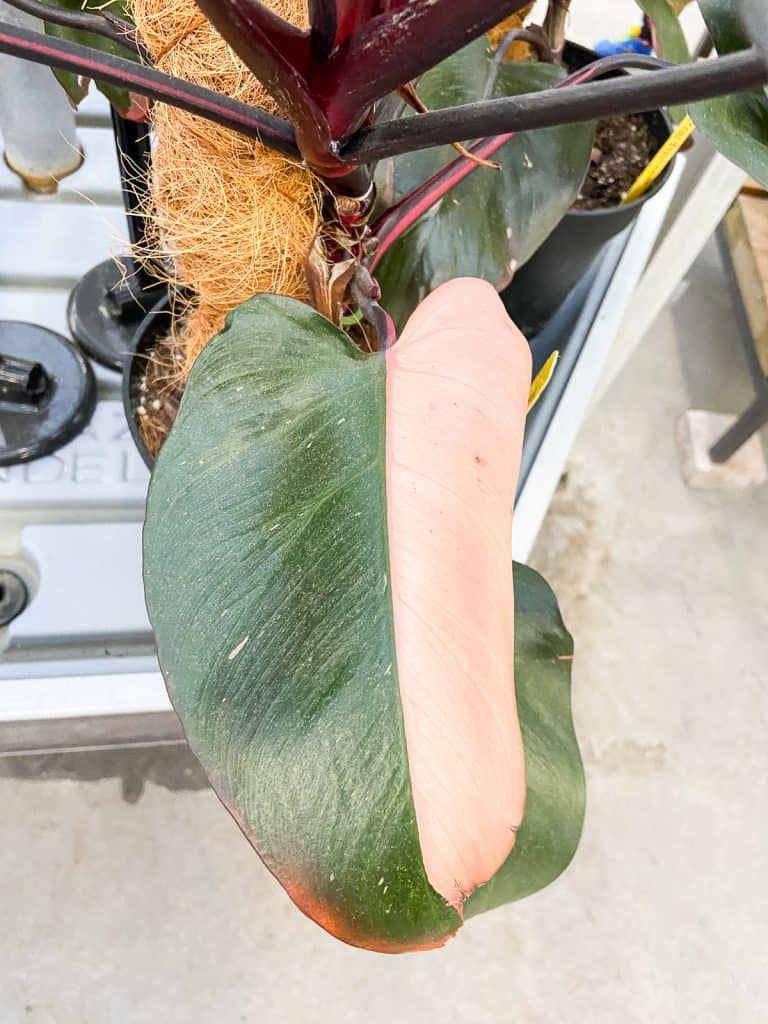Known best for its beautiful foliage and easy care, the philodendron erubescens is the obvious choice when it comes to selecting a tropical houseplant. Read on for this ultimate care guide on how to care for a philodendron erubescens.
Table of Contents
Philodendron Erubescens Background
They go by many common names: the blushing philodendron, red-leaf philodendron, imperial red philodendron, but their botanical name is the Philodendron erubescens. Native to the tropical rainforests of Central and South America, the philodendron erubescens is one of the most unique and exotic houseplants.
These indoor plants are sought-after because of their blushing beautiful leaves and deep red flowers. They are identifiable by the reddish-hue that can be seen on the underside of the leaves.
Philodendron erubescens is a rapidly growing plant; in the wild it can reach a length of 60 feet long. In an indoor setting, you can expect these plants to reach a manageable length of 3 feet long.
Even though these are indoor plants, like all other philodendrons, the erubescen plants are toxic to both animals and humans. Please exercise extreme caution in keeping these plants out of reach from curious children and pets.
Find non-toxic pet friendly plants here!
Philodendron Erubescens Care

This post includes affiliate links.
Sun & Light
The blushing philodendron plants prefer shadier conditions; it is recommended to avoid placing these plants in direct sunlight altogether. When it comes to the philodendron erubescens plant care, it is best to place it in an indoor location with bright indirect light or filtered light to expose those blushing beautiful leaves.
Soil Type
Conveniently, the philodendron erubescens plant is very tolerable of most types of soil and potting. You could take the quick and easy route and buy any standard houseplant potting soil mixture from your local plant nursery or wherever potting soil is sold near you.
You can amend the soil mix of the philodendron plants with additional sand to increase the drainage, but it is not a necessity. As for soil acidity levels, a neutral to acidic pH level is preferable when potting these plants.
How to Water Philodendron Erubescens
The blushing philodendron plants are drought tolerant, but they do best when the soil is slightly moist. A good rule of thumb when you to go water philodendron erubescens is to allow the first 2 to 3 inches of soil to dry before rehydrating your plant.
Always be careful not to add too much water to the philodendron plants, which can lead to a myriad of problems including root rot.
Fertilizer
Regular fertilization during the spring and summer is helpful in encouraging vigorous plant growth for your philodendron. Shop for a balanced houseplant fertilizer, and apply this 1 to 2 times a month to the philodendron plants throughout the spring and summer.
The plants will need less fertilizer during the fall & winter; when the dormant season approaches, cut back fertilization to once every other month.
Temperature & Humidity
Similar to other philodendrons, the philodendron erubescen plants thrive in warm, humid conditions. Try to maintain an indoor air temperature between 55° to 85° F to keep the philodendron plants comfortable.
As for humidity, it is important to maintain at least 50% humidity in the room for the philodendron plants. You can help sustain a humid environment for the plants by using an indoor electric air humidifier.
Pruning & Maintenance
While you don’t have to frequently prune the blushing philodendron plant leaves, occasional pruning and care is good to help curb long or leggy growth. If you’re cutting down growth on the plants, the ideal time to care and prune philodendrons is during the spring or fall.
To ensure the philodendron plants grow at a normal rate, you can also prune dead and damaged leaves throughout the whole year as you see fit.
Choosing a Container & Repotting
Philodendron plants, like many houseplants, require a pot that has drainage holes. Drainage holes allow for excess water to exit, which keeps the soil comfortably moist, but not waterlogged. Drainage is a huge factor in maintaining a healthy philodendron plant, as it helps prevent fungal diseases that is brought upon by trapped moisture in the soil.
If you have young philodendron plants, they will grow more rapidly, therefore frequent repotting is more common. Be prepared to repot your juvenile philodendron plants once a year in order to allow space for them to grow. As the philodendron plants get older and slower, potting should be done every other year.
How to Propagate Philodendron Erubescens
The philodendron erubescens can be propagated via stem cuttings or divisions. The process to propagate philodendron erubescens plants is very easy and straightforward.
The best time to propagate your plant is in the springtime, when your philodendron has entered active growth; however, you can also propagate an overgrown plant any other time of the year.
Follow these steps to propagate your philodendron:
- Prepare a new container for the new philodendron plant. Fill a plant pot with houseplant soil mixture and lightly moisten it.
- Inspect your philodendron plant for the idea location to cut. If you’re using stem cuttings, take stock of the stems, and locate a stem that has multiple aerial roots. If you’re using division, locate a stem growing from the side of the mother plant.
- Taking a sharp, sterile pair of scissors, make a cut around the other stems to remove it from the mother philodendron plant.
- Transplant the philodendron stem into the new container with fresh soil.
- Care for the new philodendron plant by placing it in bright, indirect light and add water to keep the soil lightly moist.
- After 3 to 4 months of propagating philodendron erubescens, with the proper light conditions you should notice new growth appearing on your philodendron.
If you choose to do water propagation, be sure to check out these fun water propagation vessels!
Common Philodendron Pests
Unfortunately, the philodendron erubescens is susceptible to a number of common household pests, including aphids, mealybugs, scale, and whiteflies. Most pests are sap-sucking, which means that they latch onto the leaves and suck out the nutrients, rendering your philodendron plant malnourished.
The silver lining is, all of these pests can very easily be dealt with using simple solutions and care. One of the most popular methods of pest control is by spraying neem oil on your affected philodendron plants. Neem oil is a natural and light pesticide and works well to curb infestations on your philodendron plants.
In addition, a mix of 2 1/2 tablespoons of Dawn dish soap combined with 1 gallon of water is another effective pesticide. With both methods, you may have to reapply this spray for a few days before the pest infestation has become completely eradicated revealing those beautiful philodendron leaves.
Common Philodendron Diseases
Like many humidity-loving plants, the philodendron erubescens is susceptible to a couple fungal diseases, namely fungal leaf spot. Fungal leaf spot appears as brown or yellow spots riddling the leaves of your philodendron plant.
Leaf spot can be prevented by avoiding getting the leaves wet as much as possible; water your plants close to the base and avoid overhead watering, but still making sure that they are receiving the right amount of humidity.
If your philodendron plant has already been affected by fungal leaf spot, spray the philodendron leaves with a fungicide of your choosing and periodically check on the status of the leaves to ensure they are getting enough fungicide.
Root rot is another common disease that occurs in philodendron plants that are given too much water. Root rot occurs when there is too much moisture and water, but not enough drainage in the pot. Trapped moisture causes the roots to break down, leading to a dying, yellow plant.
Fortunately, root rot is totally treatable when caught early in the pot of the philodendron plant.
Follow these steps to remedy root rot:
- Carefully remove the plant from the pot. Dump out the soil and throw the pot away completely, as it may harder residual bacteria.
- Inspect the roots; rotted roots are black and mushy, as opposed to firm, white healthy roots.
- Using a sterile pair of scissors, trim away at any signs of root rot.
- When you’ve successfully cleared all rotted roots, repot your plant. Be sure to use fresh soil and select a sterilized pot that has unobstructed drainage holes when potting the plant, and water accordingly.
FAQ
In the wild, the blushing philodendron erubescens is an aggressively climbing plant; as it matures in your home, it will eventually need a structure to guide it to climb on. Your philodendron may have difficulty latching onto the climbing pole at first, so it will need to be briefly trained while it is secured in its pot. You can guide your philodendron up a trellis by fastening the plant to the climbing structure using plant ties.
Yellow leaves on an otherwise healthy philodendron can be a sign that your plant is receiving too much direct light. Please keep in mind that when it comes to blushing philodendron care, these plants prefer indirect sunlight. In their natural habitat, these humidity-loving plants are shaded by the tropical rainforest trees and therefore the leaves do not get direct sun. Providing indirect light in your house helps replicate the philodendron’s natural home as well as the appropriate amount of water.
When given the best possible care and the appropriate amount of light and water, you can expect your philodendron erubescens to live for up to 20 years.
The rarest Philodendron on this list is the Philodendron Spiritus Sancti. With only a handful of these unique foliaged beauties in the wild, this endangered species is the rarest Philodendron variety. This plant is also one of the most expensive Philodendron varieties available.
The philodendron erubescens has a couple variants that are very unique; I highly recommend getting your hands on them if given the opportunity:
1. The Philodendron erubescens ‘Green Emerald’ variety of the erubescens has uniformly bright green leaves, as opposed to the red undersides that the erubescens red emerald has.
2. The Philodendron erubescens ‘Pink Princess’ variety has marbled pink and green variegations covering the leaves of this philodendron.

Overall, the philodendron erubescens is a versatile, low-maintenance member of the philodendron genus. Owning a philodendron erubescens is like bringing a piece of the rainforest into your home with little to no effort!
Want more philodendron care guides? Check out one of these plant posts!

